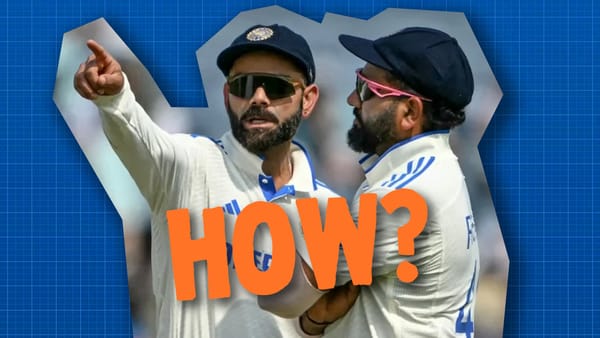Green and the change
With DRS, Test cricket is a different game than at the lower levels.
Let me just start with, fuck racists.
We don't know what happened at the SCG yet, but if it was racism against the Indian team, I'm ashamed as an Australian and a cricket fan. If this has happened, these are shit Australians and shit cricket fans.
Racist cricket fans are not new, and Australia's long history of racism is an ongoing fight. But happening twice in one Test, after a year of Black Lives Matter, it's just fucken shit. Racism is always shit—the reality of it, what it really means, and what it leaves behind.
But mostly, you feel for Mohammad Siraj. At the start of this Test he was crying during the Indian national anthem. A few days later, he has to stop the match because of abuse about who he is. I know little about Siraj. I love how he bowls, and even more how he appeals. Obviously, he has been through a lot recently with the passing of his father. But I just hate he had to go through this. But also what incredible respect I have for what he did, the courage and strength to stop the game.
We talk a lot about standing up to racism, he just did. The tears remain, the meaning only changes.
This is about Cameron Green's front pad. Commentators started talking about his stiff front leg by the second Test. You can make seven million first class runs. But international cricket tears your game apart. Super slow-mo shows flaws, a former player notices a kink and some geek like me finds things that no one ever bothered to look at earlier.
Cricket is different at the Test level.
Someone recently pointed out how little practice professional cricketers have with four-day red ball cricket before they turn pro. Think of a basketballer or footballer. By the time those athletes are around 12, they are playing the adult professional version of the game more or less. There will be minor rule changes, the time of the game might be slightly shorter, but they're playing their sport as they will have to when they make it to the big time.
That's not quite the case for most cricketers. Before they turn pro they might play some two day cricket, and occasionally get a three or four day game. Most cricketers only regularly play these games once they become professional. So that means bowling your fourth spell, the second new ball, and how the pitch degrades over four days is often new to these players.
And if you're good, in the first few years of being a professional you'll probably play Test cricket. Which again is different from first class. They are obviously more similar than the jump from the odd two day game to first class, but there are some differences.
One is the conditions, on a fundamental level, first class cricket prepares you to play at home. You'll play half your cricket on one pitch, and the rest will be probably a variant of that. It's nothing compared to how the WACA in Perth and Providence Stadium in Guyana are almost two different sports.
There is the extra day, which changes life for bowlers, and for batsmen, it brings in fifth day batting. But in general Test pitches are flatter, and better than anything in first class. Sometimes the balls are different as well, I remember Ajantha Mendis turning up in England and telling his coach, "I can't bowl with the Dukes" a week before the first Test.
Another twist for batsmen is there's a weird leap with how much bowlers know about them. I remember talking to a player who was very clear about the hardest thing about starting in Test cricket. It was facing the same bowler in eight consecutive innings. That doesn't happen in first class cricket.
And now we have added something else, DRS. A few years ago I checked if LBW decisions had changed in Tests because of it. But LBWs started changing before DRS. Thinking now it makes sense, umpires were seeing their every decision on TV, and they saw the truth of ball tracking.

Major changes in LBWs:
Spinners hit the stumps a lot more than pace bowlers
Getting a stride in doesn't matter as much
Pace bowlers bounce the ball over the top a lot
The ball isn't always slipping down leg
The TV companies changed the way we thought about LBWs, and then DRS has changed them more. For instance, it used to be that a batsman leaving the ball would be given out LBW under the oft used "Use your bat" protocol. It meant that we had many batsmen given out leaving to heinous calls because umpires didn't like that they left the ball. This is not a very common dismissal any more.
But if you have played any club cricket in the last ten years, you will understand the cameras haven't trained amateur umpires as much. Many of those old beliefs persist. First class is probably somewhere between amateur and Test in their umpiring. But having watched more first class streamed in recent years, I can tell you the quality of the decisions are far worse. And some of those poor decisions are from old fashioned LBW umpiring.
Now think of Cameron Green and the stiff front leg again. That limb is 21 years old; only a few years ago he was playing club cricket over two days. Since then he's probably had around 60 games at the professional level. And in all of those, that front leg was holding up a 200cm man.
Being really tall at the lower levels means your front step has near mythological stride patterns, meaning you're now less likely to be out LBW. It's one reason tall batsman take that big stride. And that works well at club level, it probably stays handy in first class. Then at Test level, DRS and ball tracking trained umpires to think completely different.
For a batsman, the thing that has got them into the team is suddenly a weakness, and they either aren't able or just won't adapt. Some batsmen spend a very long time trying to change their test technique but never get it right. Others don't change it at all.
Green has in just three Tests. The results aren't that important. These weren't quite junk runs, the pitch is up and down, and Ashwin and Bumrah are in the attack. But he came in with a lead of 250. If you can choose a time to bat in Tests, when your team has a massive lead and the star spinner has lost his thumb is a good moment.
But the runs aren't what has impressed me in this innings, it's what he has done. In the first knock, Green opened up his front leg a little. It didn't help him at all, he was out for a 21 ball duck, his second LBW.
It's not just his front leg that has changed, he also worked on batting further down the wicket.
Cameron Green - Average Interception Point v Pace (distance from the stumps):
— The CricViz Analyst (@cricvizanalyst) 1:09 AM ∙ Jan 10, 2021
1st Test - 2.01m
2nd Test - 2.14m
3rd Test - 2.35m
#AUSvIND
A part of me isn't sure that coming down the wicket actually helps that much with DRS. Perhaps it allows more of your contact points to be outside off stump, though if Green's front pad is starting closer to leg, then maybe not.
I'm not sure Green was better around his leading leg. He just wasn't dismissed that way this innings. But this isn't really about Cameron Green's front pad. It's about how three Tests in he has the intelligence, courage and ability to change what got him here.




